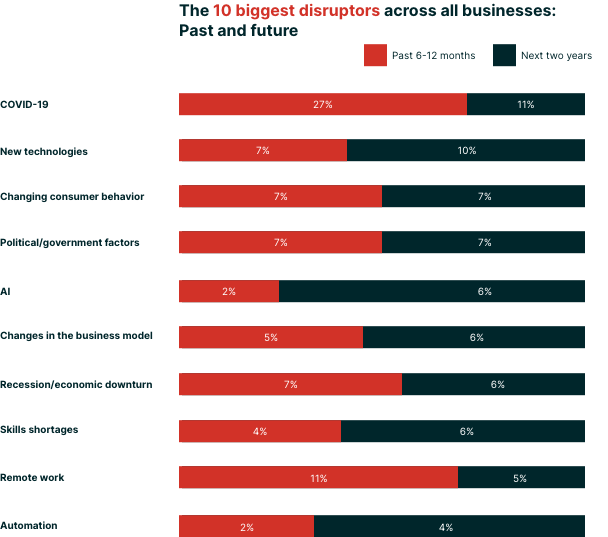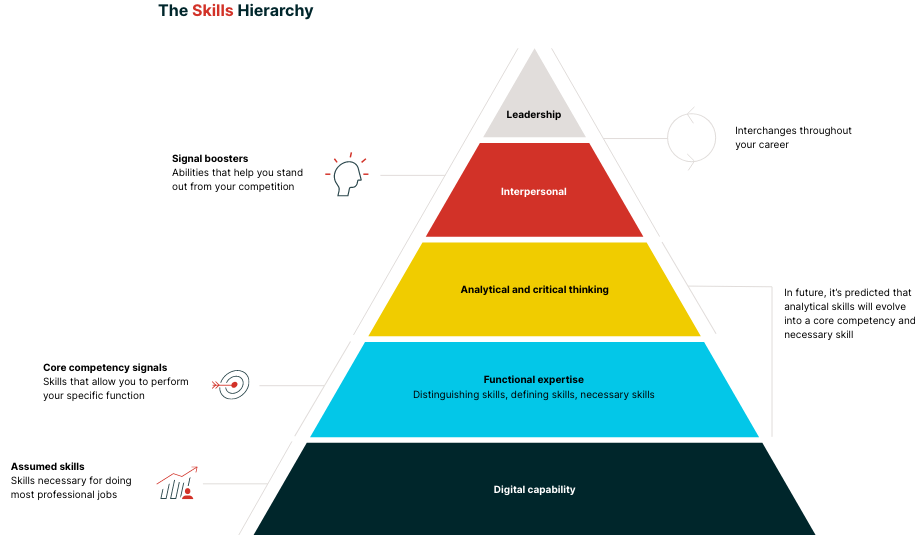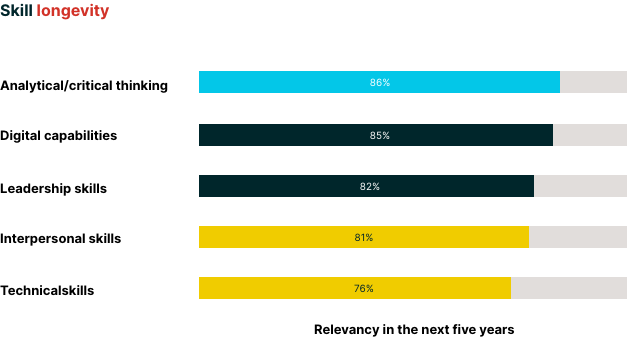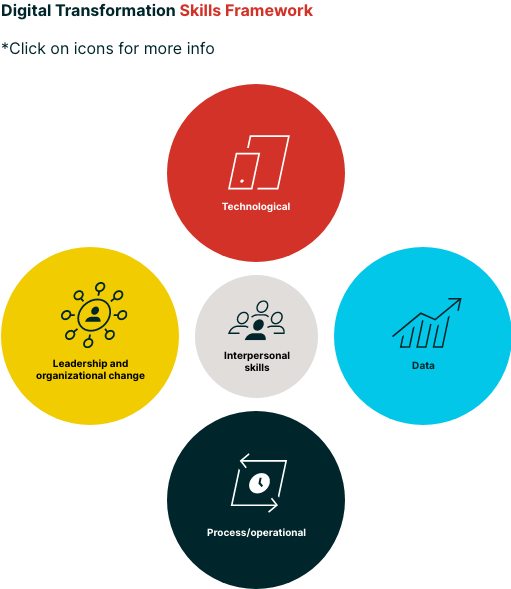Today’s businesses are experiencing tremendous pressure to keep up with human, social, and technological changes. For one, we don’t work the way we used to. We work through digital tools, remotely or in hybrid arrangements, for longer careers and more employers, at full-time jobs and side hustles. Then, there’s our ever-changing world of technology where nothing ever really stays the same.
It’s no wonder that skills gaps are growing across several industries, making it often difficult for organizations, and the professionals who work for them, to adapt to the dynamic demands of their market. McKinsey research shows that even prior to the COVID-19 pandemic, 59% of leaders already felt that skills building was essential to long-term growth.1 That figure has since risen to 78%.2
While technology and digitalization present opportunities for positive change, these can’t be utilized without appropriately skilled professionals — learning and development (L&D) managers — to guide their organization through appropriate developmental programs, and help professionals apply their newly learned skills.3 Nor can such programs be easily set up without a strategy in place, and often without outside expert support.
The age of disruption
We live in an age of volatility, uncertainty, complexity, and ambiguity, all of which lead to rapid change within businesses. These are the 10 biggest factors causing disruption across organizations: 4

It’s no surprise COVID-19 sits atop the list, having accelerated and amplified the impact of other factors, such as digital transformation in businesses.5
Regardless, all the disruptors above are shifting the skills requirements for a host of industries, most notably financial services, advanced technology, and telecommunications. The business areas most affected, meaning those experiencing the greatest skills gap, are data analytics, followed by IT management, executive management, HR and talent management, and sales and marketing operations.6
How professionals and companies are responding
A recent GetSmarter survey of nearly 6,000 people across 128 countries found that 58% of respondents anticipated needing to learn new skills for the current job within the next six months.7
Currently, C-suite professionals are learning more than anyone else, with 57% engaged in reskilling. That’s good news, because it indicates that a majority of business leaders recognize the need to address and close the skills development gap — an understanding that may lead to more learning opportunities across all professional levels.
And while many professionals may still feel that they are solely responsible for their career development, it doesn’t necessarily have to be so — in fact, more and more L&D managers are being tasked with setting up upskilling and reskilling programs.8 In fact, L&D managers have never been so valued, nor under such pressure. Without them, and without an enterprise development team, businesses that want to help their employees upskill run several risks, such as:
- A disconnect between upskilling choices and the organization’s needs and goals
- Haphazardly designed programs with minimal impact, or impact limited only to certain teams
- Lengthy launches of skills development programs
- Low retention levels, due to a lack of real career-partnerships meant to help employees on their professional journey
How to close the skills gaps
To address these issues, leadership, talent, and L&D managers typically focus on three strategies: hire, reskill, and upskill.
Hire:
Talent and recruitment teams face a shortage of applicants, let alone highly skilled ones, which forces them to look at hiring differently.9 Here are a few steps you may want to take if your organization faces similar challenges:
- Change recruitment mindsets to focus on the desired skills rather than personalities, and welcome a broader diversity of backgrounds.
- Review hiring procedures to ensure promising candidates are not rejected by traditional screening methods.
- Look beyond traditional labor pools to include older workers, those with disabilities, foreign talent, and veterans.
Hiring is also timely and expensive — in the U.S., it takes an average of 36 to 42 days, and costs $1,633, to fill a position.10 Moreover, when unemployment stands near historic lows, as it currently does in the U.S., it also leaves very little available talent to pick from.11 To top it, the “great resignation” spurred by the pandemic has seen record numbers of people leaving their jobs, creating significant issues for hiring teams. Case in point, of all hiring managers surveyed by Prudential Financial:12
- 58% don’t receive enough applications to fill their vacancies.
- 71% say the applications they receive don’t match the skills required.
- 82% are willing to hire someone who requires initial training.
That last statistic is particularly telling: New-hire training may be a solution for many employers, and could be for your organization, too. For instance, Netflix recently employed this tactic to improve workforce diversity, by partnering with edX and establishing the Netflix Pathways Boot Camps to teach industry-relevant tech skills to under-represented populations. By doing so, Netflix, in partnership with edX, grew a more diversified, and qualified, talent pool.
Reskill:
You don’t always have to look to the external talent pool to bridge skills gaps — you could focus instead on reskilling your current staff. A World Economic Forum survey found that 50% of workers would need reskilling by 2025, and 40% of respondents expected that to take six months or less. 13
From a financial perspective, reskilling makes sense. A report by the Financial Services Skills Commission in the UK found that reskilling a financial services employee costs an average of £31,850, compared with a redundancy and rehire cost of £80,875 — a saving of £49,025.14 It’s therefore not surprising that 53% of business leaders prefer reskilling over engaging freelancers or contractors, or even hiring new talent.15
Reskilling is also a key way to retain talent — it not only offers learning opportunities, which leads to an increase in job satisfaction, but it also promotes internal mobility. A recent Gallup survey found, for example, that 57% of workers in the U.S. want to update their skills, and so much so, that 48% would even consider moving jobs to improve skills. But, here’s the good news: According to the same Gallup survey, not only do 71% of workers in the U.S. report an increase in job satisfaction through training and development, 61% of workers consider learning opportunities a good reason to stay at their job.16
In other words, the opportunity to retrain at work could be a big retention incentive for employees at your organization, especially those who may want to pivot careers.
Upskill:
Reskilling gives employees the chance to develop new skills. Upskilling, on the other hand, helps them augment their existing skills on a continual basis so that they can adapt more easily to the evolving requirements of their jobs and careers.
Upskilling can prevent skill gaps and develop better resilience against accelerating change.17 Though not always, it’s also often done within hybrid roles — these are jobs that include both technical expertise (hard skills) and traditional (soft) skills such as leadership.18 For example, an employee who learns to automate everyday tasks, and applies their learning to their work, can soon free up more time for strategic thinking and collaboration.
What skills you need to prioritize
Many of the skills required to keep pace with modern businesses and industries are naturally aligned with digital capabilities. However, as digital capabilities become assumed for most professional jobs, the key differentiators among candidates are increasingly more human-centric: analytical and critical reasoning, interpersonal skills, and leadership abilities.19

There are also many advantages to focusing on human-centric development. Skills specific to particular jobs — such as software proficiency, programming languages, coding, or digital marketing capabilities — will require more frequent upskilling. On the other hand, analytical skills, human-centric skills, and the fundamental capabilities required to leverage digital tools have much greater longevity.20
What’s also clear is that digital transformation in organizations is majorly influencing what we should be learning, when, and how. Ultimately, you and your L&D team will need to balance both types of skills: the ones needed now, and those your organization will need later.

Your guide to digital transformation skills
GetSmarter’s Digital Transformation Skills Framework lists the key capabilities your employees should have to stay on top of current and future digital skills and technologies. It also provides a foundation on which to build your L&D programs.


This framework places interpersonal skills (such as critical thinking, emotional intelligence, creativity, and adaptability) at the center of four other categories of skills that organizations may want to develop now and for the future.21 It also speaks to many of the skills gaps that organizations currently face, yet those skills are the most valuable capabilities to have if you’re aiming for a successful digital transformation.
The future of skills development
Skills development is no longer simply a business augmentation; it’s an essential component of survival, both for organizations and for individual professionals. Companies with a view to the future continue growing because they understand that to learn is to innovate.22
There may be no one-size-fits-all approach to skills development — each organization, team, and professional being unique — yet two aspects of it are a must for all:
- In the age of disruption, skills development should be conducted on an ongoing basis as part of any organization’s strategy for closing continually evolving skills gaps.
- Skills development should take place across an organization, rather than in silos; if technical teams are getting upskilled, for example, then leadership should be learning how to better support the new needs and goals of those employees.
Owing to time, budgetary, and remote-working pressures, training programs will also likely have to be delivered through digital channels, which have the advantage of being easily scalable — but the digital aspect is no surprise: Learning, in the era of digital transformation, has already gone digital. What is more, remote learning has the potential to deliver essential skills quickly and prompt employees to exercise them immediately on the job, improving engagement and performance.23
With this in mind, edX For Business can help you curate a holistic skills development strategy, across a range of disciplines and learning styles. From closing technical skills with boot camps, to leadership development with executive education courses or company wide upskilling with open courses — edX For Business can help you future-proof your workforce.
Are you keeping pace with today’s fast-changing skills requirements? Learn how edX For Business can help future-proof your people and your business, by helping you close skill gaps.
Accelerate the workforce of the future, with edX
Whether you’re a business leader, L&D executive, or other professional, we offer compelling data and insights for why an outcomes-based skills program is key to succeeding in tomorrow’s workplace.
- The Skillful Corporation. (undated). McKinsey. Retrieved June 15, 2022.
- The Skillful Corporation. (undated). McKinsey. Retrieved June 15, 2022.
- The Future of Work Is Here. (2020). GetSmarter. Retrieved June 15, 2022.
- Level Up: Why Digital Transformation Calls for New Skills. (2022). GetSmarter. Retrieved June 15, 2022.
- What Digital Transformation Means and How It Impacts You. (2022). GetSmarter. Retrieved June 15, 2022.
- Beyond Hiring: How Companies Are Reskilling to Address Talent Gaps. (2020). McKinsey. Retrieved June 16, 2022.
- Level Up: Why Digital Transformation Calls for New Skills. (2022). GetSmarter. Retrieved June 16, 2022
- Level Up: Why Digital Transformation Calls for New Skills. (2022). GetSmarter. Retrieved June 16, 2022.
- How to Address the Skills Gap. (undated). SHRM. Retrieved June 17, 2022.
- Everything you need to know about cost per hire. (2022). Recruitee. Retrieved June 17, 2022.
- As Some States Hit Record Low Unemployment, Fed Faces Tough Adjustment. (2022). Reuters. Retrieved June 17, 2022.
- Pulse of the American Worker Survey: Building the Future of Work. (2021). Prudential. Retrieved June 17, 2022
- The Future of Jobs Report 2020. (2020). World Economic Forum. Retrieved June 16, 2022.
- Reskilling: A Business Case For Financial Services Organisations. (2022). Financial Services Skills Commission. Retrieved June 16, 2022.
- Rethink Capabilities to Emerge Stronger From COVID-19. (2020). McKinsey. Retrieved June 17, 2022.
- The American Upskilling Study: Empowering Workers for the Jobs of Tomorrow. (2021). Gallup. Retrieved June 16, 2022.
- Hire, Reskill, or Upskill? A Guide to Smarter Skill Development. (undated). Protocol. Retrieved June 15, 2022.
- The Future of Work Is Here. (2020). GetSmarter. Retrieved June 15, 2022.
- Five Pioneering Skills You’ll Need By 2025. (2021). GetSmarter. Retrieved June 16, 2022.
- Level Up: Why Digital Transformation Calls for New Skills. (2022). GetSmarter. Retrieved June 16, 2022.
- Your Human Capital Strategy for Digital Transformation. (2022). GetSmarter. Retrieved June 17, 2022.
- Organizing for the Future: Nine Keys to Becoming a Future-Ready Company. (2021). McKinsey. Retrieved June 16, 2022.
- Closing the Capability Gap in the Time of COVID-19. (2020). McKinsey. Retrieved June 16, 2022.